8 Key Customer Satisfaction Metrics You Should Pay Attention To
Customer satisfaction is an important indicator for businesses to develop the market and improve the quality of products and services and the competitiveness of other brands of the same type. However, how to measure customer satisfaction is a difficult and time-consuming problem.
Why should you measure customer satisfaction?
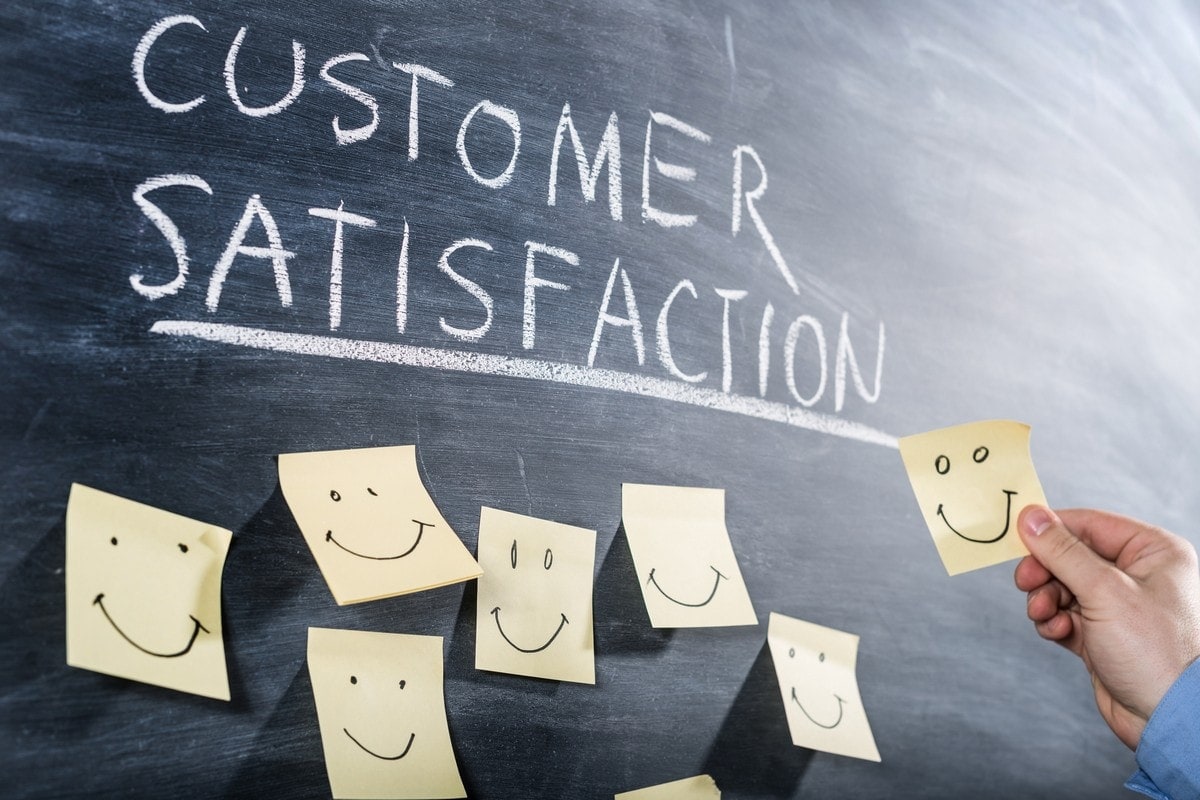
Customer satisfaction (the satisfaction of consumer needs and wants) is the degree of their satisfaction status when purchasing and consuming a product.
Consumer satisfaction depends on:
-
Customer’s expectation: This is the most basic standard in customer satisfaction assessment. Customer satisfaction will depend on the degree of difference between expectations and actual experience. If the actual results match your expectations, your product service will surely satisfy customers. Conversely, if the customer has high expectations of your brand, but the actual experience is not enough, the customer will not be satisfied.
-
The ability to return: Customer satisfaction will determine the next times to use the service. The cost of a new customer is 7 times the cost of retaining an old customer. And there is no reason when customers experience a good service or product that they are not willing to return.
-
Ability to recommend products to friends: This factor shows that customers are satisfied with your business.
-
Overall satisfaction: The question is how customers feel about all stages of the process of experiencing your service or product. And you will understand where your business stands in the minds of your customers.
To “retain customers” and expand the market and increase the number of customers, a business needs a high level of customer satisfaction. Measuring customer satisfaction is the way to understand the needs and wants of the number of old customers. At the same time, continue to promote and bring the company’s products to new customers.
Measuring customer satisfaction will also help businesses understand customers’ future shopping and consumption trends and improve their position when competing with competitors in the same industry. This is also a tool to connect between customers and businesses.
In other words, the level of customer satisfaction will reflect the profit and the growth or failure of the business in the operation process.
Satisfied consumers will become loyal customers of the business. On the contrary, if they are disappointed, they will have negative reactions to the business.
Which customer satisfaction metrics should you keep a close eye on?
Net Promoter Score (NPS)

Net Promoter Score is abbreviated as NPS - one of the metrics measuring customers’ loyalty and affection towards products/services. Simultaneously, this is also an indicator showing how many people are likely to recommend to relatives and friends to use the product? How many people will give others negative feedback about the quality of your product/service?
NPS was established in 2003 and up to now, thousands of companies know and use it. More than 65% of the world’s top 500 companies have used the NPS index to check how corporate brands are standing with their customers. Since then, it can handle existing problems and contribute to the development of brand quality.
In summary, the purpose of the NPS improvement is to understand customer satisfaction and connect it to the business’s actual growth in the future.
NPS is calculated by the formula: P - D = NPS, using the percentage of customers who are satisfied with the product (P) minus the percentage of customers who are not satisfied (D).
More simply, just give an example: “How likely is it that you would recommend this detergent to your relatives or friends?” There are scores from 0 to 10, customers will conduct scoring and divided into 3 groups as follows:
From 9 - 10 points: Promoters - is a group of customers who are satisfied with the product and will buy back and recommend to acquaintances of this product.
From 7-8 points: Passives - a group of customers who do not have loyalty to the product. They can use the product, but can also change it if they find another product more beneficial.
From 0 - 6 points: Detractors include customers with an offensive attitude towards the business. They often underestimate the quality of your product and drive away your potential customers.
A specific example to better understand the benefits of the NPS index is as follows: Surveying 10 customers. Which includes: 6 customers rated 9 points, so Promoters = 60%, 3 customers rated 8 points, so Passives was 20%, 1 customer rated 4 points, so Detractors was 10%. The NPS for this survey is 60% - 10% = 50%.
Thus, the NPS index here shows that 50% of customers are likely to be loyal and recommend your business to acquaintances. To achieve the remaining 50%, businesses must overcome the weaknesses of their products/services and focus on potential customers.
Customer Health Score (CHS)
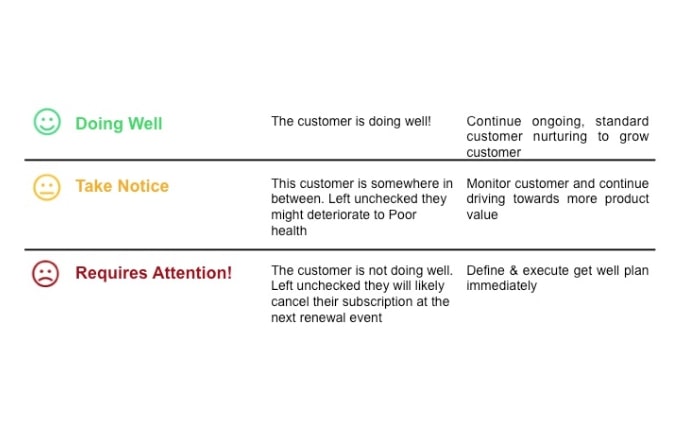
Customer Health Score (CHS) calculates the likelihood of your relationship with customers may change in the future. This bases on the customer behavior and then you can use that information to improve your interaction with them.
Different requirements from the health score… may vary among different companies and businesses. For instance, one company may want to know the likely outcomes of upselling strategies, while another may seek the information to measure the churn rate of customers.
Customers will be fully satisfied, give positive reviews or introduce to your next potential customers once they experience such great service or excellent products. However, there are always chances that their reaction may be negative when you aren’t up to their expectation. Or in other words, you aren’t up to speed with your customer’s health score.
CHS plays an important role in upgrading your customer service. From collected data, feedbacks, you’ll address the issues, improve insights into each customer’s concerns – which will result in less churn rate, increasing potential customers, greater retention and sustainable growth.
Customer Satisfaction Score (CSAT)

Customer Satisfaction Score (CSAT) or can be understood as the index of customer satisfaction. This is a direct measure of the customer’s perception of the product/service experience. This metric has a score of 1 to 5 and is represented by five face states. At level 4 “satisfied” and level 5 “very satisfied”, the percentage of this indicator of total customer reviews is the CSAT.
Formula for calculating CSAT:
CSAT = (number of good reviews + favorite customers)/Total number of reviews.
The purpose of using the CSAT index is to solicit opinions and evaluate the level of customer satisfaction with products and the quality of accompanying services such as promotions, delivery, customer care that businesses. providing. The factors mentioned above are factors that contribute to customer satisfaction. From there, businesses can adjust working style, productivity as well as time, workspace to suit customers’ wishes.
The benefits of CSAT index for businesses is to help businesses know what factors make up the quality of products / services that satisfy customers. To create an effective advertising plan and business strategy, to satisfy and retain customers. In contrast, for customers, the CSAT is a reliable source of information for you to decide whether to buy and use a product or not, based on the experiences of those who have used it.
Customer Effort Score (CES)
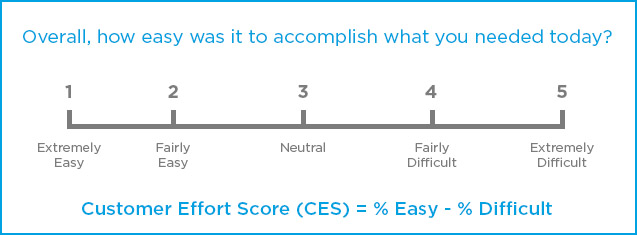
Customer Effort Score (CES), abbreviated CES is the index of customer effort. Understandably, this is an indicator indicating whether a customer is advantageous in accessing a product/service or not. If your brand is known and remembered by customers, the CES index will be high and vice versa.
Enterprises can survey this measure of customer satisfaction by asking the question: “Did you know our products easily or not?”. The scale of CES is from 1 (very difficult) to 5(very easy). The company can measure the CES index through the survey as soon as the customer accesses the product or interviews through the customer care.
The purpose of this indicator is to know whether a product/service is being widely advertised to customers. From there, it is possible to promptly handle marketing problems as well as methods of bringing products into customer awareness.
For businesses, the CES index will be a part to help predict customer loyalty and buying behavior. This will be an indicator to support businesses in increasing advertising channels to lower customers’ efforts when coming to products/services.
For customers, CES helps customers to self-assess their needs, equivalent to an easy service approach, whether to use the product next time or not.
Customer Service Satisfaction (CSS)
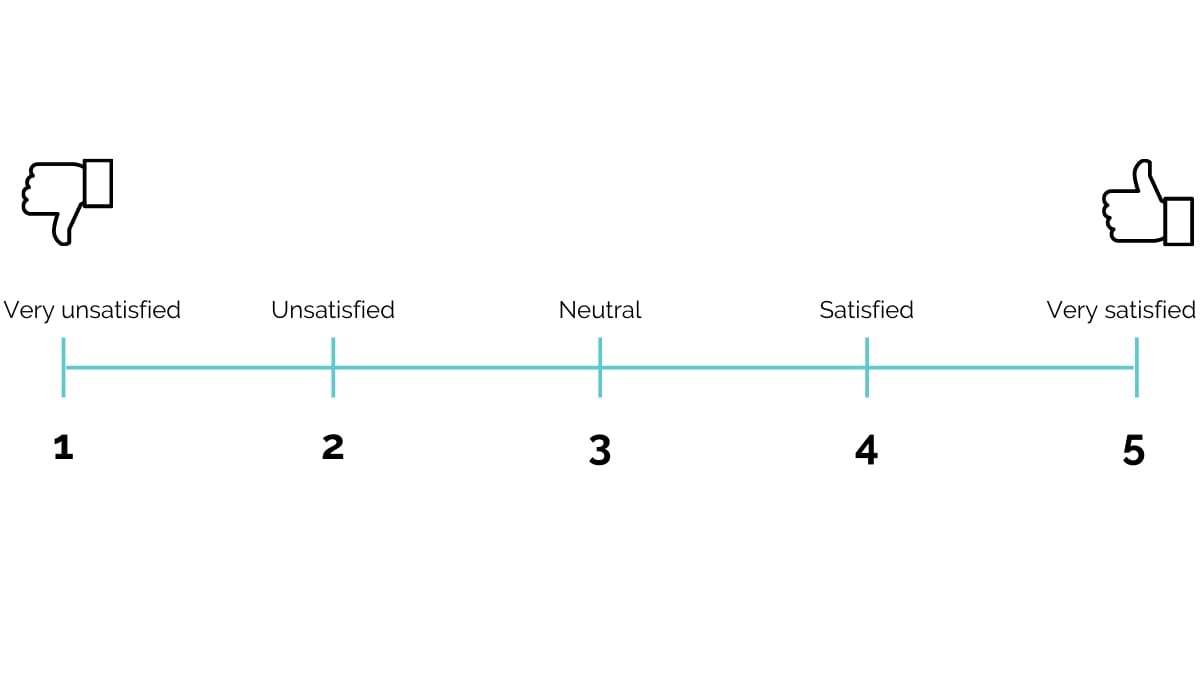
Customer Service Satisfaction (CSS) are used to evaluate your service. You can measure whenever your customers interact with your business by placing CSS questions or online surveys at the end of webchat or a phone call. CSS just uses a simple 1-3 or 1-5 scale.
CSS only measures specific interactions – not your whole business, which is slightly different from regular Customer Satisfaction Score (CSAT). Therefore, CSS can’t help you in telling anything about broader product concerns and makes no sense in multi-channel journeys.
Online rating/reviews
When it comes to using ratings/reviews as a brand strategy, here are some very compelling statistics for this thesis:
- 90% of customers read reviews before viewing a product.
- 31% of customers tend to spend 31% more with extremely good reviews.
- 72% of customers only take action after reading a positive review
Reviews can help improve business performance. Thus, you need to have a clear strategy, track and improve, communicate more frequently with customer service and can help you understand what your customers want from your product, try to improve and drive better reviews.
Customer Churn Rate (CCR)
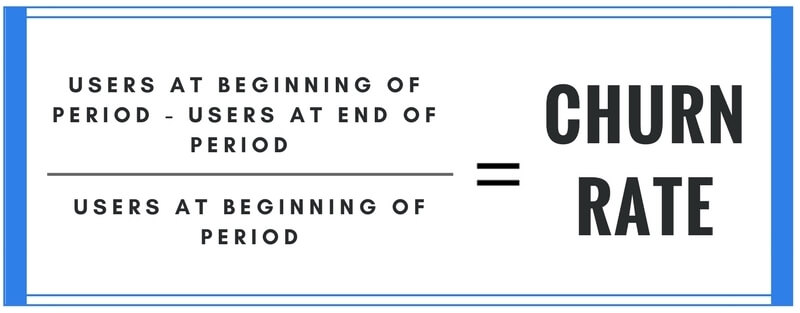
Customer Churn Rate (CCR) is understood as the rate or percentage of a brand’s customers or subscribers that canceled or failed to renew their subscription within a given period of time. The Churn Rate is an extremely important metric for companies doing business on a contractual customer base - meaning the customer will pay for the service on a monthly, quarterly, or annual basis.
CCR can be one of the defining metrics that shed light on the actual growth of a business. Regardless of the brand’s monthly sales, if a typical customer doesn’t give the business enough time to recoup the average Customer Acquisition Cost (CAC), the business is in trouble.
Sudden changes in customer exit rates signal a business that can provide urgent feedback on new prices, products, competitors and policies and should be monitored continuously. to prevent this unfortunate incident. In fact, many businesspeople find that retaining an existing customer is much more effective than finding a new one. Consequently, a robust and comprehensive strategy to prevent customer departures will help ensure your focus is on maintaining and growing its customer base.
Once you determine that the customer departure means a lot to your business, you can move on to calculating this ratio. Although the ratio ratio is more consistent with SaaS (Software as a Service) business models, it can be adapted to suit the E-Commerce industry and be the goals your business wants to achieve.
To calculate CCR in a business, the inventor needs to specify a period and check the total number of customers the brand has acquired and the number of customers that left during that period. Then, divide the number of unsubscribed customers by the total number of customers the business has and then multiply that decimal by 100%, we can calculate the percentage of customers leaving.
For example, if you have five customers that cancel and you initially signed 200 customers in that period, your dropout rate would be 2.5%.
Abandonment Rate

Abandon Rate is the rate of phone calls to an operator or service desk where a customer hangs up before talking to the operator. This rate is calculated by dividing the number of missed calls by the total number of incoming calls (in percent). The rate of missed calls is directly related to waiting time. The longer a customer has to wait before being connected to a dealer, the more likely the dropout rate is.
For example, if a center receives an average of 1,000 calls per day, of which 40 are missed by the customer, the dropout rate is 4%. The high rate of missed calls may indicate that the resource allocation at the operator’s switchboards or service desks is ineffective, which can also cause a company to suffer a reputation for providing services. poor customers. It can also drive a company off business and offend many customers. Anyone who has spent a significant amount of time waiting in a virtual queue for customer service can verify for this discomfort.
How to measure customer satisfaction?

Measuring customer satisfaction is a process-intensive job that cannot be stopped after just one survey. Therefore, to achieve maximum efficiency, you need to know how to measure customer satisfaction.
Evaluate customer satisfaction through surveys
This is a traditional but very effective method to measure customer satisfaction thanks to its practicality. To capture the satisfaction as well as customer opinions most closely, businesses can build a survey, including NPS-related questions such as: “Do you agree to introduce a product to friends or not?”, CSAT, for example the question:”Do you feel satisfied with our products or not?” and the question the CES index might be: “How much do you have access to our products?””. There are ways to do customer surveys as follows:
Use online surveys
Using online surveys in today’s digital age is very simple. There are many survey sites launched to help businesses survey customers in the age group, who the product is serving or is targeting.
Or, if the business has its own survey, it is also possible to send emails, encourage customers to survey on the company’s website to measure customer satisfaction.
Organize quarterly meetings to help measure customer satisfaction
For most industries, businesses can use regular customer meetings to promote products as well as learn about the user experience through face-to-face interviews or on-site surveys.
Organizing monthly, quarterly or annual meetings will help customers understand the needs of customers in the most detailed way, promptly change the way of working, and improve product quality. with the most customers’ expectations.
Use automatic features
Normally, when a customer orders a product on an e-commerce website, there are rating tools such as stars (stands for NPS index), smiley faces (CSAT index) so that customers can mark them. Score and comment right below that product.
Emails that are automatically sent when a customer orders may also include a number of questions for the business to measure customer satisfaction.
Solution to improve satisfaction
Achieving maximum customer satisfaction is the goal of every business, so applicable solutions to measure customer satisfaction include:
-
Improve product/service quality to the needs and expectations of customers. Immediately handle comments and feedback on poor product quality or outstanding problems while taking care of customers. Limit customer complaints to the lowest level, especially with interactions on social networks, the community. This is the most sustainable method for customers to be satisfied with your business.
-
Promote methods of advertising products and services so that customers know your brand. At the same time create trust and commitment to customers. Absolutely not false advertising, bring the right products as described with the fastest and most reasonable approach to customers.
-
Enhancing accompanying services, such as Fast delivery, return policy, warranty, best customer care and guidance, practical promotions, consistent with customer tastes. These services have a high “customer retention” and are easy to perform. Loyal customers will often be the brand promoters to help you only from these bundled services.
-
Build up the company’s internal apparatus well and equip your organization with an employee engagement software, because when an enterprise has professional, enthusiastic and deserving employees, the employee’s attitude towards customers will also be good and make customers satisfied.
Management effectiveness index helps measure customer satisfaction
It can be understood that the management effectiveness index is an index that reflects the quality of the product/service objectively, as feedback from customers when directly using the product. When businesses understand this index, they can evaluate the effectiveness of measuring customer satisfaction, as well as find a method to improve the quality of products/services in the most optimal way.
To measure customer satisfaction, businesses need to understand the factors and indicators that affect the customer experience, perceptions and spreads. When managing these metrics, businesses will surely take the right and successful steps in bringing their products/services closer to their customers and at the same time have a huge advantage over their com.
New Posts







